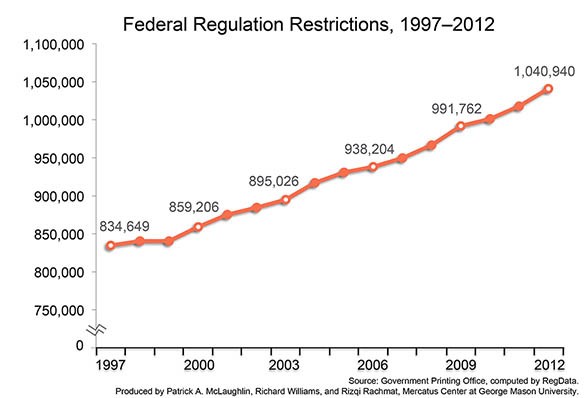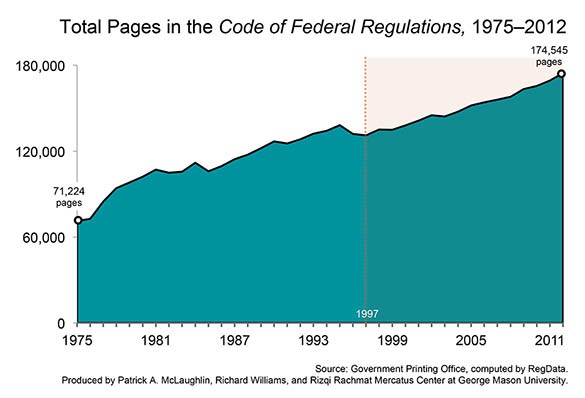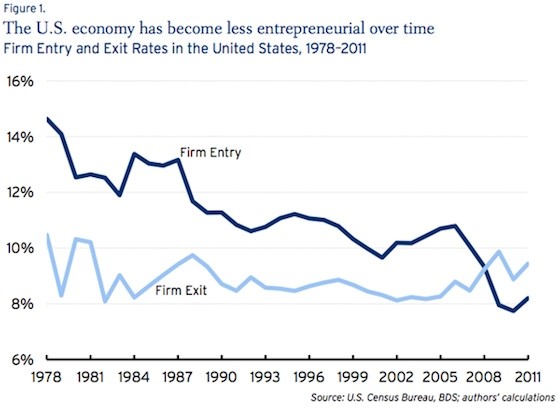
President Obama’s last great push to slow the oceans’ rise and heal our planet, headlined by the EPA’s new proposal to intensively regulate power plant emissions, has industry and conservatives warning of dire economic consequences. For example, the U.S. Chamber of Commerce predicts that the new EPA regs will cost $859 billion by 2030 (an average of over $50 billion every year), eliminate hundreds of thousands of U.S. jobs and increase electricity costs across the country. The GOP (unsurprisingly) concurs, predicting the new regulations will kill the U.S. coal industry and its 800,000 jobs. And the Heritage Foundation last year found that the President’s Climate Action Plan would “cost hundreds of thousands of lost jobs and $1.47 trillion of lost national income by 2030.” Meanwhile, nervous Democrats – still smarting over the ignorant masses’ refusal to embrace Obamacare – are bracing for more “political fallout” in areas that depend on energy or (shudder to think!) just plain “dislike federal intrusion.”
Really, though, all these Nervous Nellies just need to relax because none other than Nobel Laureate Paul Krugman is here to reassure them (and us!) that the President’s new climate regulations are not only not an economic clusterfark, but also, like, totally awesome for the U.S. economy:
You may recall that five years ago, Krugman explained how the climate bill being considered in 2009, much more stringent than EPA’s proposed rules, would boost economic growth because it would “create major incentives for new investment — investment in low-emission power plants, in energy-efficient factories and more” during an unprecedented economic slowdown.
In his new column, Krugman repeats that point. “The U.S. economy is still depressed — and in a depressed economy many of the supposed costs of compliance with energy regulations aren’t costs at all,” he writes. “In particular, building new, low-emission power plants would employ both workers and capital that would otherwise be sitting idle, and would, if anything, give the U.S. economy a boost.”
In this regard, Krugman clearly views the new EPA regulations as similar to other unexpected, non-market phenomena that he’s praised over the years like… alien invasions:
“If we discovered that space aliens were planning to attack, and we needed a massive build-up to counter the space alien threat, and inflation and budget deficits took secondary place to that, this slump would be over in 18 months,” Krugman says, referencing an episode of The Twilight Show in which an alien threat was manufactured to bring about world peace.
… and earthquakes/nuclear meltdowns:
And yes, this does mean that the [Fukushima] nuclear catastrophe could end up being expansionary, if not for Japan then at least for the world as a whole. If this sounds crazy, well, liquidity-trap economics is like that — remember, World War II ended the Great Depression.
… and, of course, terror attacks:
These [9/11] aftershocks need not be major. Ghastly as it may seem to say this, the terror attack — like the original day of infamy, which brought an end to the Great Depression — could even do some economic good.
Dude. Seriously.
Now, as anyone with a rudimentary grasp of economics can tell you, Krugman’s beliefs about the magical, stimulative effects of natural or man/alien-made disasters reflect the “broken window fallacy” – a long-since-debunked bit of economic alchemy helpfully explained by GMU’s Walter Williams as follows:
Almost anyone with a speck of brains would recognize equating economic growth with destruction is lunacy….
[French economist Frederic] Bastiat wrote a parable about this that has become known as the “Broken Window Fallacy.” A shopkeeper’s window is broken by a vandal. A crowd forms, sympathizing with the man. But pretty soon, the people start to suggest the boy wasn’t guilty of vandalism; instead, he was a public benefactor, creating economic benefits for everyone in town. After all, fixing the broken window creates employment for the glazier, who will then buy bread and benefit the baker, who will then buy shoes and benefit the cobbler, and so forth. Those are the seen effects of the broken window. What’s unseen is what the shopkeeper would have done with the money had the vandal not broken his window. He might have employed the tailor by buying a suit. The broken window produced at least two unseen effects. First, it shifted unemployment from the glazier, who now has a job, to the tailor, who doesn’t. Second, it reduced the shopkeeper’s wealth. Explicitly, but for the vandalism, the shopkeeper would have had a window and a suit; now, he has just a window.
In the same way, the broken window fallacy (not to mention common sense and lots of history) belies the silly idea the idea that the EPA’s new regulations will magically revive the U.S. economy by forcing American companies to commit new and significant resources that they otherwise would not have committed to environmental compliance. Put simply, it ignores how those resources would have been committed in the absence of the EPA’s top-down, centralized mandates. (Plenty more economics here, if you’re interested.)
That said, by implicitly equating the EPA’s onerous new regulations with terror/alien attacks and natural disasters, Krugman may actually be on to something. Indeed, the economic devastation caused by U.S. hyperregulation is well-documented. As GMU’s Mercatus Center recently explained—
A recent study found that the accumulation of federal regulations slowed economic growth by an average of two percent per year between 1949 and 2005. Several earlier studies using broad indexes, such as those produced by the World Bank and OECD, have permitted cross-country comparisons of the effects of certain types of regulations. These studies have also found that regulations can slow growth when they impede innovation and entrepreneurship.
Mercatus then proceeded to provide the following charts demonstrating the horribly-depressing explosion of U.S. regulations in recent years:


The latest edition of the Competitive Enterprise Institute’s The Ten Thousand Commandments adds further insights into immense costs that the regulatory state imposes on the U.S. economy, especially families and small businesses:
- Costs for Americans to comply with federal regulations reached $1.863 trillion in 2013. That is more than the GDPs of Canada or Australia.
- Regulatory costs amount to an average of $14,974 per household – 23 percent of the average household income of $65,596 and 29 percent of the expenditure budget of $51,442. This exceeds every item in the household budget except housing – more than health care, food, transportation, entertainment, apparel, services, and savings.
- Small businesses pay more in per-employee regulatory costs. Firms with fewer than 20 employees pay an average of $10,585 per employee, compared to $7,755 for those with 500 or more employees.
Coinciding with all this regulation and economic pain is a distressing decline in U.S. business dynamism, as demonstrated in a new, eye-opening report from the Brookings Institution. The report’s authors found that not only are more U.S. businesses dying than are being created (the first time ever)…

… but also that “older and larger businesses are doing better relative to younger and smaller ones.” (Yay, cronyism and transaction costs!)
When pressed on the causes of this problem, the right-wing hacks at Brookings took a wild guess:
[W]e have speculated in comments since our report that mounting regulation – from all levels of government – could be one factor frustrating job reallocation while tilting against entrepreneurship. Younger, smaller firms do not have the resources that larger, more established firms do to hire full-time attorneys or compliance officers, which should put them at a progressively larger competitive disadvantage as regulations continue to grow in number and complexity. In other words, we think a more relevant conversation isn’t a generic one about regulation per se, but one that considers if our regulations systematically disadvantage entrepreneurs vis-à-vis incumbents and larger firms. We want to stress that this “cause” for declining dynamism is only a hypothesis at this stage, and awaits confirmation by future researchers, but it seems to be a plausible contributing factor.
Yeah, given the strong and obvious correlation between U.S. hyperregulation and declining economic growth and business dynamism, it’s pretty safe to say that the former is more than just a “plausible contributing factor” to the latter, wouldn’t you agree?
So, given these facts, I think that I can confidently say that I, for the first time since the 90s, fully agree with Paul Krugman: the economic effects of the EPA’s new regulations, and the President’s overall Climate Action Plan, are exactly like those of a natural disaster or alien attack. Unfortunately for Krugman and the U.S. economy, that’s a very, very bad thing.
The views expressed herein are Scott Lincicome’s alone and do not necessarily represent the views of his employer, White & Case, LLP.








